Another perfectly breezy day brightened Oslo.
Fully rested, we woke and descended for a lavish breakfast. Each morning, Lewis and I enjoyed people-watching as we spotted new guests or observed the antics of sleepy ones.
We feasted on sunny-side-up eggs, with ochre-colored yolks (not a genetically-modified "yellow") and perfect consistency—never runny. I added spoonfuls of roasted potatoes. With tongs, Lewis put crispy bacon, turkey meatballs, and smoked sausages on our plates.
For a change of scenery, we sat in a lower-level room that spaciously overlooked the street. We liked the faux flaming (colored vapor) fireplace. (Nordic hospitality features a fireplace throughout the year).
We descended the staircase, said "Hei hei" to the Front Desk staff, and the automatic doors slid open for our exit.
Outside the hotel, we "stumbled upon" Stumble Stones in the sidewalk. In Norwegian, they are Stolpersteine. We first noticed Stumble Stones in Amsterdam in 2019. During our trip to Berlin, last year, we saw more. Found across Europe, they are brass plaque memorials that honor the lives lost to Nazis during World War Two. Oslo has 393 stumble stones.
A stone by the hotel gives remembrance to Sofie Springmann, who was born in 1896. During the Nazi Occupation of Norway, 768 people with Jewish heritage were deported to concentration camps for "extermination". She was killed by Nazis in 1942. The metal stones are intended for people to suddenly notice... and remember that history. We did.
Before our trip, Lewis and I learned about Norway during WWII. Before the war erupted, Adolf Hitler offered Scandinavian kingdoms a non-aggression pact on April 28, 1939.
Mistrusting him, the three kings rejected it (although the King of Sweden admired some Nazi ideals). WWII began on September 1, 1939. The British government intended to occupy Norway to protect its huge Atlantic coastline against the Nazis, but its dithering officials waited too long. On April 9, 1940, Nazi-controlled Germany ignored Norway’s neutrality and invaded. Hitler dispatched Germany’s 69th, 163rd, 181st, 196st, and 214th Army Infantry Divisions. A German flotilla aimed for Oslo and sank three Norwegian warships. Norwegians were astounded by the sight of 10 German battleships, two heavy-cruisers, and four destroyers.
However, Oscarsborg Fortress opened fire with artillery guns and land-launched torpedoes that halted the German Navy. The attack sunk Germany’s heavy-cruiser flagship, Blucher, which shocked the Germans and prompted them to retreat. That moment allowed the Norwegian Royal Family to escape from Oslo.
They and the Storting boarded a train to Elverum. The Storting supported the King to rule Norway during the indefinite duration of the war. The Nazis pursued them. However, they were ambushed and repelled by the King’s Guard. Fighting fiercely, the guardsmen gave enough time for the royals to evade capture. On April 10, King Haakon met the German envoy, Curt Brauer. Brauer obeyed Adolf Hitler and demanded that the King dissolve the parliament and appoint a Nazi sympathizer to lead a new one.
The King stated that he would never comply. In retaliation, Germany sent its Air Force to bomb the village where Norway’s Council of State was regrouping. Meanwhile, the Allies in Europe retreated from the Nazis and abandoned efforts to bolster Norway. The King chose to form a government-in-exile. He voyaged to the United Kingdom and relocated his officials to London. For the next five years, the King orchestrated strategies, spies, fundraisers, and radio broadcasts for his kingdom from London. In fact, the King of Norway resided inside Buckingham Palace, as a guest of the English king.
Alas, the Nazis used their Blitzkrieg style of air-and-sea warfare, and troops parachuted into the capital’s airfields to neutralize Norway’s aircraft. Troops of Germany’s Wehrmacht marched confidently into the capital—with a military band playing boastful music.
By April 14, Germany had 25,000 troops in Norway. Confusion, obsolete weapons, and an unclear government hampered Norway’s efforts, but the army fought bravely. Yet, Nazi Panzer tanks and motorized machine gun battalions overwhelmed them. After two months of fighting, Norway was overrun by the Nazis (while the world watched the Nazis defeat France).
Hitler’s government considered Norway to be a Germanic nation of “Nordic Aryans people”, so it controlled Norway with a gentler suzerainty.
(Denmark also cooperated to protect its population and accepted a status as a “protectorate”). 300,000 Germans were garrisoned in the kingdom throughout the war. Enforcing gubernatorial duties, a Reichskommissar from Berlin supervised the occupied nation, yet it was a “puppet government” for Hitler.
For five long years, Norwegians fought against occupying Nazis to regain their independence. 2,000 men and women died in battle or by Nazi executions. Demolition specialists, hijackers, spies, assassins, and saboteurs sought to disrupt Nazi operations: trains, water supplies, factories, ammunitions shipments, and paperwork amassed by the Gestapo. The Army remained in its homeland and dispersed its manpower, so each municipality had leadership against the Nazi occupiers. The Royal Norwegian Navy escaped with most of its ships to the UK and participated in the Invasion of Normandy (D-Day of 1944), when the Nazis began losing the war. Citizens contributed to “civil disobedience” to distract Nazi authorities. Students of Oslo University formed intelligence-gathering networks that were hugely efficient.
In 1942, the Nazis who controlled Norway withheld salaries from teachers, and they arrested 1,100 male teachers because they didn’t support the Nazi regime (and its propaganda). 642 were sent to the Artic for forced labor. “Illegal” newspapers were printed “underground” and distributed to loyal Norwegians to tattle on Nazi maneuvers. Norwegians spread believable rumors that Allies intended to recapture coastal territories. Consequently, German naval assets were deployed uselessly—preoccupying several hundred-thousand troops—and that kept them away from the real places that Allied forces attacked. Lookouts helped the Allies destroy the huge Bismark battleship. Tradesmen, housemaids, and farmers smuggled people in and out of Norway. Many evacuees were Jews who fled from Nazi death-camps, but others included foreign spies, British military strategists, and scientists. Sweden was neutral during the war, but its Red Cross smuggled Jews to safety, and it constructed training camps for 8,000 Norwegian freedom-fighters. From America, the future director of the Central Intelligence Agency came to Norway to help them. Eventually, Allied troops and Americans liberated Norway!
Citizens were jubilant and the Crown Prince was celebrated for his heroic efforts. (He remained a popular king, too).
It made us value the kingdom's post-war improvements! Similar to China and Japan, they made enormous changes in a short time.
Our own country had no wartime damage, yet it destroyed its own historical structures for overpopulation and tries to poison it overtaxed citizens with innutritious food, ongoing pollution, chemical pharmaceuticals, and furnishings/clothes/cosmetics derived from petroleum byproducts.
*To see people's photographs from WWII that signify their sturdiness, please use this link: https://halfwindsorfullthrottle.blogspot.com/2019/02/captivating-world-war-two-photographs.html
Norwegians have nice lives (in one of the Happiest Places).
Thanks to our hotel's central location, getting to the National Museum only required a brief walk. Last year, the National Museum of Art, Architecture & Design reopened in its new location on Queen Maud's Street, facing the waterfront. It’s amazing!
The gargantuan $650 million facility draws together collections from five previous museums: 6,500 items dating from antiquity to modern-day. Highlights include Norwegian arts-and-crafts, the thousand-year-old Baldishol Tapestry, royal outfits, porcelain from Imperial China, contemporary fashion, and 18th-century portraits. Last year, the Norwegian Royal Family performed the grand opening. Six years earlier, Crown Princess Mette-Marit laid the cornerstone. In her speech, Queen Sonja stated that the superb facility belongs to everybody, and it provides stewardship of artwork and masterpieces for new people during the next century. This year, the King knighted its Executive-Director.
Misinformation online said that Oslo's big museums are free (as museums are in London). That is untrue; the admission price equalled $20 per person. It was a worthy investment.
A security guard assessed that Lewis' should-bag needed to be stored in a locker, but mine was okay. We stored both. Impressively, the downstairs locker area was always staffed with three attendants. Many people (within Norway's trusting society) simply left their coats and umbrellas dangling on hooks or garment racks. It's nice to see honesty in a society.
Relying on push-button codes, the lockers were easy to set and use. That experience was far-greater than any of our museum visits in Berlin.
Returning to the main level, we perused paintings of Norse fairytales that were made by Kittelsen in 1911. We noticed a reoccurring theme about a fictional adventurer named Halvor. In an adventure tale titled Soria Moria Castle, the young man treks for an entire day to reach a castle that shimmers on the horizon. He deals with a princess and a three-headed troll. Trolls are popular characters in Norse mythology as evil and benevolent. Halvor appears in folktales published by Asbjornsen & Moe. In all of the plots, Halvor overcomes many obstacles. He dreams big and doesn't give up, and he eventually achieves his dreams. That resonated with us, as we deal with unfair requirements for relocation... but we don't give up either.
Seen below, the painting titled In the Month of June was created in 1899 by L.A. Ring in Denmark. The young woman sitting on a porch of a pastoral scene seemed somewhat sad, as if her black dress sweltered her, while her studies prevented her from experiencing the lovely day beyond. Lewis thinks that she is sleeping while the book lays open on her lap.
We were awed by the 1882 oil painting titled Breakfast by Gustav Wentzel of Norway. He technique to bring metal objects to a shiny liveliness was impressive. Everything seemed so real that we could imagine touching them.
We were not opposed to imagining ourselves with the cuties in the next painting. Their fey features seemed content. Lewis observed the tattoos on both forearms.
Our favorite gallery consisted of oil paintings by Thorvald Hellesen from the 1920s. His style is evocative of the Roaring Twenties.
Lewis liked his oil painting from 1921 titled Dance.
In his creation below, our imaginations recognized two eyes, a nose, and a tongue hanging out of a mouth. Look to the left, and you'll see it, too. In the center, your imagination may see another face—configured by two reddish circles as eyes, vertical/angular shapes as a nose, and two reddish parts as lips. On the right, I imagined that the perspective was looking down on the heads of two dancers.
Artwork is nourishing for the mind!
Alas, the "modern abstract art" area was a cliche of scams, as usual. Some idiot got paid to put a collapsed shipping box in a picture-frame and call it "art". Another buffoon made a video of a chubby man jumping in his underwear. More imbeciles tried to admire it for a "perspective of social framework".
We prefer true talent.
In the other wing, a special exhibition featured stylish garments from two queens. Some gowns belonged to Queen Maud, but many items were loaned to the National Museum by Her Majesty, Queen Sonja.
Her Majesty's coronation gown and cape got special attention.
Queen Maud's stylish wardrobe from the 1920s and early 1930s was represented beautifully. The Norwegian queen was svelte.
We noticed that quite a few "queens" were attracted to that exhibit. We also noticed that gay men in Norway have a tendency to "announce themselves" discreetly by positioning their legs askance.
We saw it several times, and it is done by single men to identify themselves to gay/bisexual onlookers who "cruised" the museums. If they saw a guy admiring them, they made that leggy pose, and then looked to see if it worked to encourage their admirer to come closer. Such subtly doesn't exist in NYC where men grab their crotches with vulgarity and allow five seconds for you to respond.
Another roomful of admirers gawked at a repertoire of vintage clothing and contemporary fashions. Nice.
Seen below, the shoes were made in 1923 by Hook, Knowles & Company in England. I liked the beadwork. English shoes are always great.
In a glass case, we studied the delicacy of a châtelaine (keyholder for the keeper of a castle) from 1781, made in France.
As a fan of mechanical watches, I liked the enameled gold pocket watch that was hand-crafted in France in 1780.
Arriving on the second level, we paused to admire the cafe. The menu was meager, but we respected that food was served on reusable glass and porcelain. Classy. We also liked the sensibly-built seats. The swerve-shaped sofas were dotted with tiny tables, and they were equipped with electric sockets. Clever ideas that should be in all museum cafes!
We were equally wowed with a convenient button in the lavatory. If pressed, it summoned a cleaner to tidy the lavatory. That was the first time that we saw such helpful service! Oslo is amazing with its service and cleanliness. Tiny print under the button emphasized that: "We create places that work, think, and give". Indeed!
Knowing that this was a new building, we noticed that museum architects still like to incorporate "railroad style" doorways that line up as if they were made in a 1700s-era French chateau.
On the roof, we peered down at the fjord, which sparkled in the sunlight.
Lewis investigated the interior of a mud-hut (igloo). It smelled like charred corn. He loved the coziness.
After spending joyful hours in the vast museum, we left that treasure-trove of humanity to go to the History Museum. Walking north on King Haakon VII Street (he reigned from 1905 to 1957), I saw a location for Baker Hansen, so we popped in.
Founded in 1861, the company operates dozens of cafes in the region, and they are quite good. Plush banquettes and sizable tables were appreciated. Every seat had pillows for customer comfort. Of course, thoughtfulness was applied to having flowers on each table, too.
The display-cases were brimming with freshly-baked goodies.
In contrast, nearly all coffeeshops in America are mundanely filled with the same repetitive blahness: bagels and muffins, as seen below. No variety or recipes of ingenuity. Meager. Basic. Yet expensive.
In Oslo, we zeroed-in on a sizable slice of Princess Cake for 63 crowns. Lewis also bought a mango smoothie and apple cider. Water was given (in glassware) for free. The cake was scrumptious! The marzipan was nicely flavored, and the sponge cake was puffily perfect. Layers of white cream, pink cream, jam, and chocolate chips were delicious. :-)
A loaf of oven-fresh bread was 56 crowns. Danishes and tarts cost 35 crowns ($3.27), and the size of the tarts is generously larger than the overpriced-yet-tiny ones that are found in NYC, as seen below.
FYI: a cappuccino cost $3.42 as "take-away" but $3.93 to drink in the cafe (on porcelain cups and saucers). All drinks were priced $0.47 higher for "in-house" dining. Nonetheless, that was an amazing value for us because cafes in NYC overcharge customers $5.00 for a take-away cappuccino... and $3.75 only gets you a mere espresso.
After snacking, we left our dirty dishes in a tidy cluster on the table. At European coffeeshops, the (non-tipped) staff cleans the tables and removes dishes. Guests don't do that; guests focus on enjoyment. In America, you tip the staff and you usually still clean away your dirty dishes. We like the Nordic standard: less cost, yet more service. A nice change for us.
We saw the Embassy of Ireland and walked past the Embassy of the island-nation of Iceland.
Easily identifiable on the corner of King Kristian IV Street (he reigned from 1577 to 1648), the History Museum retains its 1904 styling.
Creatively, the brass artistry on the front doors resembles a Viking ship!
We purchased our tickets (99 crowns / $9.40 each) and were permitted to keep our bags on our shoulders. Half of the main level is dedicated to a Gift Shop. We bought a Viking ship trinket—which will also be a Christmas ornament on our tree.
The cafe chairs were ingeniously designed with pouches built into the outer fabric, so you can put a book there when you want to pause from reading. Smart.
The galleries illustrate Norway's heritage from every region.
One level had an impressive repertoire of ancient Egyptian artifacts. Lewis always loves that.
The staircases are beautiful, too! They are emblazoned with Art Nouveau gilding, window ornamentation, and chandeliers.
Lewis was intrigued by their special exhibition of Japanese armor. There were 10 suits of armor dating from ancient times until the 1840s. Each was crafted for samurai warriors, so they had to be flexible but strong. Thin metal plates were coated with numerous layers of lacquer (to prevent rust), and they were held together with braided silk. Known for cleverness, the makers intended the pieces to be taken apart for renewing or replacing worn parts. They never had a "disposable society". The same logic was applied to swords. Blades were cared-for, so they lasted for centuries... while the scabbard and mountings were renewed.
The armor below was handmade in the 1770s.
According to the placard, the helmet with a rabbit was made in 1750. I'm unconvinced that wearing a bunny on your head exudes a threatening aura to attackers.
It's true that their helmets resemble Darth Vader's in Star Wars. Perhaps that was an inspiration for the films.
We were most interested in the museum's repertoire of ancient Norse and Viking artifacts—the largest quantity in the world.
Most impressive was the helmet of a female warrior. A metalsmith made it in the 900s. The killer's axe blade was still lodged into the helmet! Evidently, the burial left the weapon in the helmet... and possibly the skull.
Warped and withered from time, an assortment of swords looked like a scene from ancient mythology films. They were dated to the years 850, 975, and 1000. The tall spear was discovered on the grounds of Akershus Fortress!
We learned that Vikings included homosexuals. Seeing their gear, we can identify their priorities. Ha ha!
Unlike most other civilizations, Norse culture never tried to abolish homosexuality, but their society expected that couples made babies—regardless of anyone’s sexual preference—to perpetuate their population. Vikings who evaded marriage to pursue same-sex partnerships were scorned. So, it implies that gay men could remain intimate as long as they produced offspring. For Vikings, there was nothing shameful about desiring same-sex passion.
However, it was preferred to be a “top” who did the penetrating. Sometimes, after battles, Viking men had sex with male prisoners-of-war to show their superiority. Vikings who preferred to be a “bottom” and enjoy penetration—or were versatile—faced challenges of ostracization. As an exception, those “unmanly acts” were permissible when virile heroes needed “release” by being the "bottom".
The Norse deity, Loki, was bisexual. Odin (King of the gods) learned how to pleasure a man from the goddess named Freyja. Ancient goblets feature same-sex couples embracing. There is also evidence of gay prostitutes in Viking communities. After the pagan aspect of their culture was destroyed by Christianity in the 900s, the intolerant Catholic Church insisted on laws against homosexuality. That continued until 1972, when Norway asserted that gay people are equal to everyone else. Homosexuality was legalized in 1972—40 years before America (which pretends to be the "Land of Equality"). Last year, the kingdom celebrated its 50th Anniversary of that legalization. Now, Norway’s LGBT rights are among the highest in the world, and the “age of consent” is 16. Similar to other Nordic nations, Norway is regarded as one of the world’s most gay-friendly places.
In contrast, America's gay community is highly intolerant. Many gay men do their interpersonal networking online (which seems impersonal). At the slightest hint of disagreement, they activate the “blocking option” on their website or phone app. They block people for trivial reasons and shallow minutia. That compels men to hide their true selves—afraid of angering someone. Such unhelpful behavior is intolerable. Walking on a street in America, you can often tell that a guy is gay because he feels compelled to wear the “prescribed” outfit: short shorts and tank-tops. Many have the same haircut, hand gestures, flouncy body stances, facial expressions, high vocal tone, and fake lisp. Please use this link to learn about that:
https://halfwindsorfullthrottle.blogspot.com/2015/07/movie-review-do-i-sound-gay.html
If you enter a gay bar, 95% of men will be wearing nearly-identical outfits. That doesn’t seem fitting for a statistically “creative” group of men who supposedly desire individuality from the rest of society. After all, you cannot describe a stereotypical vegan person. You can’t stereotypically describe a person from Tennessee or Sweden. Why should you be able to describe a stereotypical (American) gay person? Gay men craved Gay Rights and didn’t want to hide anymore under false veneers of heterosexuality. So, why hide now under false veneers of stereotypical homosexuality? It’s worse when other gay men only befriend those who do it.
As I mentioned previously, Vikings didn't have a written history, but they occasionally used storytelling stones named Rune Stones. (Similarly, Native Americans didn't write their histories; they carved them on totem poles). We were honored to view the world's oldest rune stone. Carved figures indicate a momentous occasion in ancient life.
As we exited the museum, the weather provided a brief sun-shower. Using our collapsible umbrellas, we strode down (Duke) Kristian August's Street towards our hotel. (It was named for a Dane who was popular in Norway as its statholder [governor] in 1809). We freshened up and changed clothes.
Within thirty minutes, we had reservations to luxuriate in a grand hotel for a chic teatime. Sipping tea in a coddled environment seemed to embody the kingdom's notion of Koselig.
We were thrilled with our hotel's unbeatable proximity to the best Afternoon Tea offered in Oslo! We literally crossed the street and entered the Palmen Restaurant in The Grand Hotel.
The 5-star Grand Hotel is the annual venue for the world-famous Nobel Peace Prize, which is presided over by the King. In 1901, the Swedish inventor, Alfred Nobel, established the world’s most prestigious prizes for Chemistry, Literature, Physics, Physiology, and Medicine. They are awarded in his homeland of Sweden. But, he specified that the annual prize for Peace must be awarded in Oslo, Norway. (Evidently, it is considered a peaceful place).
The clocktower is always on-time. There are 284 rooms and almost all are uniquely decorated. During her stay, Madonna wanted to buy some of the chandeliers but was politely rejected. The Rolling Stones rehearsed there before their European Tour in 2014. Oprah Winfrey is another famous guest. Chuck Norris stayed there, last autumn.
Seen below, the modernized lobby has a wall of room-keys behind the Front Desk.
We arrived at a podium where a gracious lady confirmed our reservations and ushered us to a special seat in the center of the room. Afternoon Tea began!
The space was initially a stable courtyard for hotel guests, in an era of horse-drawn carriages. Now, it is enclosed with a glass ceiling that angles upward, and the room is renown for its restaurant and teatimes. Unlike in America, half of the guests in the room were men, and many customers were young.
Dangling above the room, a huge hand-blown chandelier from the Italian "glassblowing island" of Murano adds colorful panache. (Years ago, I visited Venice—a UNESCO Site—and toured the Murano workshops to watch their amazing glassblowing). The grandiose chandelier was modernized by Cerith Wyn Evans, so it gently pulsates with the music in the room. We sat under it, so we merely had to glance up to admire its beauty!
We sat at a four-way banquette that aimed outward in different directions. A towering bouquet of blooms sat atop it. There were no chairs facing the banquettes, so occupants had unobstructed views of the room. Next to each banquette, small tables held spare utensils, menus, folded napkins, and pitchers of water.
An entire wall was colored by a mural of 36 paintings. They seemed to be vignettes, and several were scandalous. A blonde woman laid on the grass with her hand between her legs. In another, her chair was knocked backwards, and a shocked man was on top of her, with his buttocks exposed from his fallen pants. In another scene, she laid on the floor with her dress pulled over her waist, while a man in green pants had his hand near her groin... while three women in gowns looked at them. Another painting posed her on her back, without shoes, her knees folded up, her dress above them, and both sets of fingers on her vagina. Farther down, another woman had a chance to have her dress up, showing her butt during a picnic. Then, the bare-breasted blonde was laying on her back. Next to that, a naked person had their head up the butt of a surprised woman. Incongruously, the Storting was depicted in a painting, and another had a museum. The bottom corner depicted a coral reef, and the Grand Hotel was painted in two central panels.
Definitely something to ponder while sipping tea in an otherwise refined setting.
We were introduced to our server, who was from the Philippines. We chose Norway's glacial-sourced tap water to drink. So refreshing! We declined to purchase flutes of champagne, but we did prefer to begin our teatime with sips of tea before the food was presented. Teas were prepared by steeping loose tea leaves, and that brew was transferred (without leaves) into our personalized teapots. We perused the selection of tea, and I eyed "The Du Hammam" green tea, which included a blend of roses, green dates, and orange flowers. Yet, I chose a robustly named "Big Ben" black tea, which was made with cardamom, rose pepper, cinnamon, ginger, and orange peel. Lewis skipped the Imperial Chai and the Tropical Oolong (enhanced with guava, maracuja, and mango), and he selected "Le Temps Retrouvé". It was a blend of black tea from China's Yunnan province and a "toasted" Japanese green tea. It had a remarkable earthy taste with honeyed overtones. Very pleasing. We were served as many pots of tea as we desired. Our porcelain was patterned with flowery blooms, but each teapot was unique: a cozy mix-and-match assortment. Some had images of Chinese pavilions as homage to ancient China as the birthplace of tea.
Unlike our teatimes served in London and Dublin, there were no courses to our meal; everything was presented at once... and there was not an unlimited supply.
The assortment of savories included a finger-sandwich filled with Norwegian salmon that was cured in gin, topped with dill and horseradish; a mini-sandwich layered with pastrami, pickled red onion and herb emulsion; an open-faced wheat sandwich with cream cheese, roasted peanuts and pomegranate...
... and quiche filled with freshly-caught (hand-peeled) shrimp, trout roe, and sour cream from Roros.
Celebrating its 22nd anniversary, Røros Dairy makes Norway's best organic butter, milk, sour cream, and yogurt. It is located in the Town of Røros, which is a UNESCO World Heritage Site. The cows enjoy a summer farm in the mountains and go to barns in the valley for the winter. In 2021, the dairy was finally granted access to sell butter in the USA. We are certain that it will outclass the corporatized American dairy industry.
The sweet segment of our menu included a blackcurrant-and-almond tart; a cup of coconut, mango and passionfruit mousse; a chocolatey opera cake with raspberry; chocolate truffles filled with pistachio and Amarena cherries (harvested in Bologna, Italy and marinated in syrup).
On the bottom tier, a plate held four oven-fresh scones that were nestled in a folded linen napkin, to keep them warm: two plain and two vanilla scones studded with apricots. They were scrummy!
Thankfully, ours looked (correctly) like this...
Instead of clotted cream, the hotel provided whipped cream. We used it, but it didn't hold the jam as well as clotted cream, and it lacked the depth of taste. Regardless, the scones were very good, and Lewis requested a fresh batch from the kitchen.
Feeling content, we paid the bill: 1,090 crowns. Lewis gave a gratuity of 100 crowns.
We washed our hands in the lavatory and loved the soap, Bal D'Afrique by Byredo.
Afterwards, we spent hours walking through the beautiful streets. At dinnertime, we left our hotel and merely crossed the park to Storting Street and dined (without reservations) at a Chinese restaurant that was aptly named Dinner. It opened in 1989. It had a posh interior, and most of the tables and banquettes were full of jolly customers.
Outside of the USA, we see local populations appreciating real cuisines from other cultures. In America, the sad reality is that Chinese families are funneled into operating dry cleaners and mediocre Chinese restaurants—which are compelled to offer cheap/low-quality food. Too many Americans consider Chinese food as take-away, and they refuse to pay for higher-priced fare. Furthermore, ignorance in America perpetuates the dumb Americanized recipes of Chop Suey, General Tso's Chicken, and Fortune Cookies (which are NOT from China). *Please use this link to learn about them: https://halfwindsorfullthrottle.blogspot.com/2016/11/our-trip-to-japan-5-of-7-kyoto-gardens.html
With parents who owned three Chinese restaurants in Manhattan, Lewis developed an appreciation for proper cookery and waiter service, and he knows what authenticity tastes like. The chef at his parent's third restaurant was Cantonese and showed him how to authentically make the recipe of Peking Duck. So, he eagerly ordered it in Norway. It was shaved from its skin at our table, and the crispy skin retained its valuable taste. We also ate dumplings, spicy battered seafood, and croquettes filled with King crab.
Our authentic-tasting dinner at Dinner cost 1,995 crowns.
The next day, we breakfasted in our hotel.
As we exited the lobby, we saw the smiley Front Desk team and said, "Hei, hei! God morgen!" Parked near the hotel, we saw a sleek Norwegian police car.
A pair of konstabels (constables) patrolled the street.
Unlike America's duplicity of federal, state, city, highway, bridge & tunnel, and transit police, Norway uses a national police service.
It began in the 1200s with 70 sheriffs who reported to the king's representative in each district. In old Norse, the term for "sheriff" was lensmann, and that title is still used for the leader of a rural police district (shire). In the USA, urban sheriffs are mostly administrative, but rural ones have power over their counties.
Constables do not carry guns. In the USA, authorities claim that if police don't have guns, there will be more crime. But look at the facts. Last year, Norway only suffered from 29 murders. Only 29 in the entire nation! (Norway's well-bred and happy society can apply its tax dollars for better things). In NYC, there were 31 killings in the month of August, and 111 rapes, 1,560 robberies, 1,185 burglaries, and 4,620 cases of grand larceny. All of that in one month of the year... and all in only one city! Many stores in NYC decided to close permanently because the police are inactive against shoplifting and looting. Yet, despite their failures—while getting the biggest budget in the world, the police demanded more money. Somehow, they got it.
What do New Yorkers get for that? Racial violence (seen above), fat cops, and idle cops who are never on foot-patrol.
Walking in the sunshine, we liked that a Metro station was only one street away.
Lewis and I were wowed by the high-tech speed of the Metro trains in Oslo. Please watch my video of their quiet acceleration...
We rode on Route #1 because it went up the mountain named Tryvannshøyden to a skiing area named Skimore. In the summer, Skimore operates a treetop ropes course and zip-lining adventure area named Somerpark. It is one of Scandinavia's largest climbing parks. Three tourist websites recommended it. It looks like this...
Regrettably, we did not notice the part on its website that said it was closed on Mondays. None of the tourism webpages mentioned that either, so I will tell you.
You don't need a car to get there; it is reachable via a 30-minute ride on the Metro. Yes, the public transit system carries you to cool places like that. The route opened in 1898 as a tramway and was upgraded beautifully to a Metro line in 2011 for the Nordic World Ski Championships. Once again, Lewis and I were thrilled with the immaculateness of the Metro because we NEVER see that on any subway or light-rail system in America. The train was clean and new, and all the cars were openly interconnected. That allowed people to walk through its entire length, to avoid congestion in one area.
NYC has the most overcrowded trains on Earth, yet it doesn’t use interconnected trains and makes it illegal to cross between cars.
In Oslo, there were no homeless people, graffiti, vandalism, beggars, or broken parts. We only saw normal people/things.
In NYC, things are the opposite. Despite living in an upscale area of Queen County near a subway route that touches Manhattan's poshest places, we must use old subway trains from 1974 because NYC doesn't care to upgrade its entire system. Residents pay $3,000 per month for apartments "near the subway" but are forced to use outdated infrastructure like this...
This year, NYC's transit authorities will increase bridge and tunnel tolls by 6 to 10%. Toll revenue is supposed to maintain those bridges and tunnels, as well as the transit system. Yet, the ongoing deterioration of bridges, tunnels, and the transit system proves that the money continues to vanish. NYC’s tolls are the most expensive in the nation (and America is a huge nation), yet NYC uncaringly demands more. Making it worse, the transit authorities announced a fare increase. The price of weekly MetroCards was raised by $1.00. Yet, since nearly everyone buys monthly MetroCards, they increased those prices by $5.00. $5.00 taken from 8 million people is a huge influx of revenue! Yet, we are certain that the transit system will squander those funds (as it has done since 1904) and let the crumbling infrastructure crumble further.
When we're outside of America, we definitely look like gobsmacked tourists because we ogle and take photos of the impressive subways/Metros. The seats were not broken, the windows were not streaked, the lights worked, trains had digital signs of upcoming stations, and they ran on-time. Even better, the trains were never delayed or paused for "train traffic ahead", or "another train using the same track/tunnel", or "signal malfunction", or "firemen responding to smoke", or "stalled trains"... as happens almost daily in overpriced NYC.
Part of the bucolic scenery included the nicest houses that you can imagine. No peeling paint, sagging roofs, broken windows, or untended lawns. Every building was properly maintained.
For contrast, this is the scenery of above-ground subways in any borough of NYC...
Mostly, it is squalor like a third-world country.
Remarkably, our Metro ride had the qualities of a funicular because the gradient rose steadily. We climbed in elevation for 531 meters, and the train did it effortlessly. (NYC subway trains can barely go around a curve without rattling, shaking, and squealing).
From our (smudge-free) windows, we gazed admiringly at valleys, forests, lakes, and mountaintops.
Peering down, we noticed that steep ravines hugged the tracks.
Its easy to understand why the city was recently idolized as the European Green Capital. The conservation of its clean air, clean water, and its advanced eco-friendly infrastructure are applaudable as a modern 21-century city.
On-time, we arrived in the Nordmarka ("North Woodland") part of Oslo: a forested region in the Borough of Marka. Despite being used for year-long recreation, its forests are havens for beavers, lynx, wolves, moose, and deer. We exited at Voksenkollen Station. It looks preserved from the 1910s.
Construction crews surrounded the station, but they were amazingly quiet. Once again, Norway is a country that differs drastically from the USA because it invests in modernly quiet construction equipment. The quietness of our departing train was still louder than all the machinery! I was tempted to video-record it. When a dump-truck dumped gravel, the sound was louder than the engines and motors. That is great engineering.
Alas, there are no signs for Skimore at the station. We would've appreciated one that indicated its hours of operation. I used Google Maps "Street View" to navigate our path up the steep road to Skimore's entrance. A lack of signage at Skimore makes us think that those idiots are either from Berlin or Helsinki.
I knew that a landmark for navigation was the unmistakable broadcasting (transmitting) tower named Tryvannstårnet.
We trudged uphill for almost one mile (1.2 km). At the top of the mountain, we saw the first sign for Skimore, but it didn't mention hours. We proceeded around a woodsy curve and saw a large parking lot. 22 cars were at the other end, near some buildings. We trekked across its length but realized that the buildings were locked and unoccupied. None of the windows had signs, and hours were not posted anywhere! What were all the cars parked there for? Just then, we spotted a man walking uphill further, along the unused ski track. We followed, but when we got there, he was gone. A sign with an arrow directed us to the Somerpark, so we began hiking downhill. Two park employees drove past us. They smiled and nodded at us. We would've appreciated it if they realized that we were misguided and told us that the park was closed. (Giving us a ride down to the station again would've been nice, too). A moment later, another pair of guys rode past us. No help from them. Didn't they wonder why we were roaming around?
We finally arrived at the ropes/zip-lining area, and we tragically realized that it was not open. Almost everything was tied-up to prevent access. I fumed and ranted about that, and I was unhappy that I previously asked two "professionals" in Oslo about Skimore, yet they knew nothing about it to warn us.
Lewis consoled me, and we suddenly noticed that the "kids area" was accessible. So, we romped on the low-level rope courses... for free. We actually had fun!
We hiked under the canopy of trees, and then we decided to return to the city. Norway was the first country to ban tree cutting. Deforestation remains a problem in the greedy USA.
Being surrounded by Norwegian Spruce trees reminded me of Christmases as a boy because my family often bought that type. To learn about Christmas trees, please use this link... https://halfwindsorfullthrottle.blogspot.com/2021/12/history-of-christmas-tree-ha-ha-that.html
Going downhill was delightful, and we were delighted further by the site of a street sweeper cleaning the mountainous bike path! That's amazing infrastructure and cleanliness. That NEVER happens in New York State.
We returned to Voksenkollen Station and waited mere moments for the down-slope Metro to arrive, and Lewis used that time to shake pebbles from his shoe.
As world-travelers, we accept rough moments with smoothness. Sometimes the rough ones produce spectacular moments. Our train rides up and down the mountain were spectacular! We were glad that we went—if only for that!
The views were awesome, as our train chugged downward. From our elevated vantage point, we saw the fjord!
More passengers joined us as we neared the city-center.
We exited at the Central Station.
Riding up the escalator to the main concourse, we were impressed that its restaurants were bustling with customers at midday.
We were still in the mood for outdoorsy fun, so we decided to take a hike along the river.
In fact, one of the top priorities for Norwegian couples is "take a walk together". Oslo's tourism website promotes it, too.
It's more healthy and gratifying than typical American pastimes.
Embarking from the train station, we paused at A Market, which is a popular Asian Market.
Its social media pages are full of impressive events and bargains for seasonal items and different Asian cultural recipes for each season. It was immaculate, which was wholly unlike dozens of Asian markets in Manhattan and Queens. Those places look like they were intended for rural peasantry. The market in Oslo looked respectable and organized.
Signs were printed in Norwegian and English.
Lewis and I browsed shelves for savory crisps (chips) and got three bags: dried prawn, sweet potato, and seaweed. We got two refrigerated bottles of pennyworth-leaf juice. Total = 85 crowns. Sipping our drinks, we went around the corner and posed for pictures on Akersbrau. It is known as the Fantasy Bridge because it has statues of fairytale characters. The fantastic bridge has a lane for traffic, but two lanes for pedestrians, and a central median of flowerbeds. That shows the capital's priorities again. Innovative seating areas are made of wood, and include ramps for handicap accessibility. The whole scene was so pretty.
Oslo is a city that uses its bridges for people-gathering, instead of only traffic congestion, as the USA continues to do. Built in 1926, it replaced a wooden bridge from 1874. It exudes an Art Nouveau style, but it earned its moniker “The Fairytale Bridge” because it has four bronze sculptures by Dyre Vaa that represent folktale heroes. They include a king who married a wicked witch and was transformed into a polar bear; a legendary deer hunter named Per Gynt (who fought trolls and rescued milkmaids); a bare-breasted version Katie Woodencloak who escaped her evil stepmother; and Veslefrikk Med Fela, a topless male youth who gets three wishes from a troll.
(Norway’s best-known folktales include Boots and the Troll, Taming the Shrew, The Lad Who Went to the North Wind, One’s Own Children Are Always Prettiest, How One Went Out to Woo, The Cock and Hen a-Nutting, The Cock the Cuckoo and the Blackcock, The Master Thief, Three Billy Goats Gruff, East of the Sun and West of the Moon, The Princess on the Glass Hill, How To Win A Prince, The Bear and the Fox, Silly Men and Cunning Wives, The Town Mouse and the Country Mouse, An Evening in the Squire’s Kitchen, The Giant and Johannes Blessom).
The Aker River divides the capital into east and west parts. Stretching for 8.2 kilometers, it flows downhill via 20 waterfalls, and its swift current powered numerous watermills. Therefore, some industrial buildings are seen along the riverbanks, and each was refurbished for new uses.
Due to vigilant conservation, the water is unpolluted, and salmon run/spawn upriver. It is ideal for rafting and tubing. We descended from the street and arrived at a place where the path goes under the bridge.
A man was fishing. Two women fed ducks, and their quacking antics amused us. We rarely see ducks in NYC’s polluted waters, so it was fun to admire them. They let us get very close, and we noticed their pretty plumage. (Waterfowl and “game birds” often have pretty feathers).
Tracing the river, Lewis and I sauntered north into a trendy neighborhood named Grunerlokka. It became part of the capital in 1858, and it was gentrified in the 1990s. It’s named after Friedrich Gruner (born in 1628) who was the Master of the Mint (coinage). He purchased the land from King Christian V in 1672. At that time, it was named Kings Mill. The river winds its way downhill and deposits mountain runoff water into the fjord.
As we strolled upriver, we were delighted that both riverbanks were full of lush lawn and shady trees. Picnickers and sunbathers used those greenspaces, and we noticed many Osloites sitting on blankets to simply enjoy coffee and conversation. Park benches faced the river, too.
None of the rivers in the five boroughs of New York City are as picturesque or easily-reachable as that. Long ago, NYC’s greed for overdevelopment and a focus on car manufacturing wrecked its riverfronts. Six-lane highways were deliberately placed against the water around Manhattan, and that severed the people’s access to the water. But on our travels to Shanghai, Copenhagen, Florence, Rome, Amsterdam, London, Paris, Helsinki, Berlin, Lucerne, Dublin, and Oslo, those cities keep their riverfront preserved for their people to enjoy.
The path narrowed against the building’s old stone foundation, and a tight curve required a railing. The river rushed around the bend and made a gurgling noise against large rocks. I love that sound. Across the river, we saw brick buildings covered with street art.
Bla Coffeeshop was there, with a spacious terrace overlooking the river. Trees sprouted from the shore and offered shade. Lewis posed for a picture on the footbridge.
Two cyclists “oohed and aahed” about the kitschy chandeliers of "reclaimed junk” and colorful graffiti. At the intersection, we saw entire walls sprayed with trendy street art.
We finally got to the famous Food Hall. Glumly, we realized that its plaza was vacant.
Two baristas at a nearby café explained, “The Food Hall is always closed on Mondays”. Great. (that's sarcasm).
I had back-up eateries pinpointed in the region. We crossed a footbridge and stood against the raging waterfall at the top of the hill. Its current seemed to be at full-force, and a cooling mist settled on our faces.
[Most of Norway’s electricity is produced by hydropower: a renewable energy source. Norway is Europe’s largest producer of hydropower, and it’s the sixth-largest in the world. While it can’t use solar power to a maximum, it’s one of the world’s biggest producers of solar silicon and solar cells. Built in 2018, it has six wind turbine farms, which is Europe's second-largest facility].
Overhead, a towering structure had been a silo, but it was converted to an apartment house. It is a landmark that architectural enthusiasts flock to.
At the next corner, we entered Tim Wendleboe Coffee Roasters. I did my own online research to find it, and then I discovered from locals that it was a preeminent coffeeshop in the capital!
The small room had plenty of seating, but it was almost full. The drinkers seemed like regulars. The three baristas were attired in crisp white shirts, black trousers, and black aprons. They worked with the precision found in a five-star hotel, and the tidy lavatory was excellent.
Alas, the shop’s warmth propelled Lewis to want to sit outside. I ordered an espresso, and I was delighted when the blonde woman asked if I preferred a fruity coffee bean or not? I did.
She relayed my order to a handsome fellow at the espresso grinder, and he ground, tamped, and pulled a perfect shot. It was concocted from Colombian beans grown on a 140-acre plantation named Finca Tahana at an elevation of 1,700 meters.
I overheard them chat with customers. A pair of Norwegians recently finished three weeks of vacation and intended to use their remaining two weeks in November. Another one just returned from spending four weeks of vacation abroad, and he also kept a week of vacation for November. I was envious; as a department manager at a nationwide company, I only get two weeks of vacation (while colleagues in Switzerland and England get five or six weeks—and that applies to new-hires, too)! They have a Life/Work Balance.
I paid via tap-and-go, but I noticed that the Tip Jar was filled with coins—not paper money. Of course, the coins that are minted in the kingdom feature the king’s image.
Behind the baristas, a shelf was full of gold-level trophies won at Barista Contests and Talent Competitions. The baristas bring your drink to you on a small wooden board, accompanied by a small glass of water and an individual creamer and sugar-bowl. That’s an elegant presentation.
Feeling hungry, Lewis wanted to continue walking, so I opted for a paper cup. We sauntered around the corner, and admired a leafy public square. The whole area is charmingly scenic. It's the way that America's Hallmark channel pretends that America still looks.
Bolstering ourselves, we lunched at Cafe Skansen, which opened in 2008. It is near the Embassies of Ghana, Myanmar, and the Philippines.
Painted in bright yellow, the historic building from the 1850s has a woody interior and a shaded outdoor eating area that some might call a "beer garden".
Lewis and I changed clothes at our hotel and decided to enjoy another urban adventure: ambling along The Promenade. It stretches for 10 kilometers, and the route is marked by orange “towers” that help you see ahead to the next destination. During our first day in Oslo, we already explored from Towers #5 to 7, as seen below...
...so we boarded a tram at the National Theatre (seen below) to go east towards Tower #9.
We alighted from the tram at Queen's Eufemia's Street to explore the main part of The Promenade. (We eventually walked all the way to Tower #12).
Several years ago, being able to do what we did was unthinkable because shipyards, highways of traffic, and warehouses obstructed access to the waterfront. Hugely unlike NYC, Oslo invested to return direct-access of the waterfront to its people. On our other trips, we used the embankments and promenades in London, Boston, Helsinki, Florence, Shanghai, and Paris, and those cities were also smart to keep traffic congestion away. However, Oslo ingeniously went one step further: a humungous step! It ripped up the highway (which would be sacrilegious in car-centric America) and ensconced it underground in a modern tunnel: out of sight and noise-free. It shifted the shipyards to another location, and it repurposed some warehouses and removed the others. Wonderful! Here are "Before & After" pictures...
We began at one of the grandest examples of Art Nouveau architecture. It is a huge pink building named Havnelageret.
It houses the Norwegian Defense Estates Agency, as well as offices for ship companies, oil companies, and financiers. Constructed in 1916, its enormous weight is supported by bedrock, 20 meters underground. When completed in 1921, it was the largest concrete building in Europe.
We heard DJ-music and joyful laughter from a waterfront cluster of buildings named SALT: stalls of "street food" and indoor saunas that accommodate groups (usually office workers). It was fun to explore.
As seen in my video, there was no traffic noise because the electric buses rolled silently onward as quiet as bicycles...
Lewis and I inhaled the lovely scent of a wood fire. There were several fires. They were aboard several "floating saunas". Nordic populations are renown for their predilection to use saunas. It's understandable that they are some of the happiest societies. You cannot find saunas anywhere along the miles of (abused) shoreline in NYC, nor are there any floating ones in its (polluted) waters. In Oslo, they are "centerstage" for access and Life/Work Balance. Being tethered to that area provides customers with great views of the city's architecture.
While the eateries at NYC's opera, philharmonic, and ballet only function during performances, the restaurant at Oslo's Opera House pleasantly serves lunch and dinner every day. Cushions are freely provided for passersby who wish to sit and gaze at the nautical beauty.
From there, we walked to Bjorvika: a new neighborhood directly behind the Central Station. Until a few decades ago, the area was a port for container ships, and it had a major highway junction.
The progressive city revisioned the area for better purposes, so it dug tunnels and moved the highway underground, and it removed the port. The waterfront was "opened up", and new life began blowing through the area via eco-friendly buildings, green spaces, waterways, and places that make you happy to be there. The most-amazing aspect is that it was built upon land that was reclaimed from the sea! That reminded us of what we saw in Japan and the Netherlands. Great engineering.
Regrettably, America is resistant to those ideals, so overtaxed Americans are plagued with swathes of highways that block and disturb access to waterfront areas. Not a Life/Work Balance.
Living in NYC's squalor, citizens make petitions but can't get the city to reclaim land to expand its woefully-outdated airports, which cause nationwide flight delays.
Naturally, any sane person would prefer Norway's ideals.
We paused in the "mixed-use" residential area named Bispevika and got juices at Godt Brod Munch. Founded in 1995, Godt Brod is an ecological bakery chain that operates 20 cafes, and that one was named for the nearby Munch Museum.
Of course, we sat outdoors to admire the spectacular scenery.
The buildings were clad in eye-catching materials.
Passive design methods blended harmoniously with views of the water and created plenty of places to sit outside. Wooden sundeck chairs were incorporated into fences by the city for public enjoyment.
We approached a playground in the plaza. Suddenly, we recognized the vicinity as the place where Maaemo was! It was startling to see that juxtaposition of refinement and frivolity. That is Life/Work Balance.
We were surrounded by gorgeous architecture: fresh, innovative, the correct height to preserve access to sunlight, and avante-garde to provide access to “the outdoors”. That means that the developers and architects designed spacious balconies—big enough for furniture and plants—and incorporated green-spaces. With brilliant planning, there were garden courtyards and parklike greenery on the roofs.
Notice the absence of bars over the windows and doors. In NYC's neighborhoods (rich and poor), residents must install bars over their doors and windows, creating self-made cages to live in, because they cannot rely on their overpaid police.
Notice the absence of ugly billboards and cellular-boosting towers on top of the buildings. That is life should be... but New Yorkers don't have it. Too many NYC landlords cheaply ignore old buildings that need investment in renovation, and they greedily beleaguer their overcharged tenants with cell towers over their roofs (is that safe?) because cell towers and billboards give them more profits.
Life/Work Balance means that your life is enjoyable when you’re at home. NYC landlords usually refuse to acknowledge that; they only build mind-numbing high-rises.
As another example, these are what typical balconies look like in NYC. Some lose space for air-conditioners: uncaringly stupid.
They are begrudgingly given by cheap landlords who greedily want to overcharge tenants by saying that their apartments have a “balcony” as an amenity. Lewis and I prefer Norway’s standards, as seen below...
We were also enamored with Oslo’s inclusion of waterways as canals. For us, it was evocative of Venice and Amsterdam. The inclusion of water with the new homes is brilliant, and the housing development included footbridges between buildings. They add a bit of whimsy to the urban landscape. Just like at Aker Brygge, the buildings were smartly designed with quays, gangways, and docks.
Osloites in that area are merely steps away from their kayaks, canoes, boats, and water-boards. That is Life/Work Balance.
Seen below, that Osloite returned home from work, changed clothes, unhitched his kayak from his building’s floating dock, and paddled into the harbor.
Those cozy canals also provide safe havens to paddle—away from motorboats. Seen below, a couple of girls took advantage of a kayak rental discount by agreeing to retrieve trash from the waterfront.
The best attribute is that the area is car-free. Parking is smartly underground. Cars use tunnels to arrive at their buildings.
Also underground is the garbage containment. We loved that!
If you're paying the highest taxes in the nation, you want your trash removal to be as sleek, efficient, odorless, and quiet as Oslo's, as seen above and below.
...every week of the year.
As usual, Oslo's retailers were trusting enough to leave racks of clothing outside unattended. Back in NYC, those clothes would be stolen within a day… and those crimes are unfixed since 1965. In Oslo, as in Copenhagen, Helsinki, and Amsterdam, shopkeepers are less afraid of shoplifters.
Using a pedestrian bridge, we arrived at a strip of restaurants that faced the harbor. (Notice that they don't need to install railings).
We noshed at Sumo, which serves scrumptious Japanese food made by talented Norwegians. Due to their shared love of fresh seafood, there are many Japanese sashimi and shushi eateries in Nordic nations. The interior was splendidly made of Nordic blonde wood.
First, we went to wash our hands. Pleasantly, the sinks had dispensers that were full of Molton Brown soap (making a gentle luxuriant lather) and hand lotion (non-greasy with whiffs of woodsy aroma). We like that British brand and remember it from our trips to the United Kingdom. It won a Royal Warrant.
The lavatories had a fun surprise: the floors in the toilet stalls are large video screens that show animated fish swimming in the sea! Enjoy Lewis' video of the remarkable scene...
We ate outside under an umbrella, with a fine view of the harbor… and the canals behind us.
We admired the kindness of architects to provide large windows for the kitchen staffs at those restaurants. Nearly all NYC restaurants shove their overworked kitchen staff into windowless overheated kitchens. Furthermore, due to NYC’s cheapness, most kitchens are ridiculously undersized and cramped for what they are expected to do. In Norway, developers create roomy kitchens blessed with daylight through large windows.
We ate five shrimp gyozas, two rolls of yellowtail tuna and prawn tempura, a softshell crab (my favorite summer delicacy), and six individual bowls of seared scallops smothered in aioli on hand-pulled noodles.
Our food was valued at 1,333 crowns. An Eastern-European server worked solo, so it took some time for everyone to be served, but none of the customers minded the slowness. Life is less hectic outside of the USA.
We ventured onto the artificial peninsula. We were repeatedly mesmerized that the whole thing was smartly built upon land reclaimed from the sea! It is mostly car-free (which reduces noise pollution and exhaust). Vehicles use a road along the eastern edge, which has its own idyllic view of water.
We were continuously wowed by the generosity of developers to provide sun decks, terraces, and swimming areas. Please enjoy my panoramic video inside the courtyard of a new housing development...
Many Osloites reclined on the (clean) wood terraces and got tans or people-watched.
Lewis and I promenaded farther along the water. Groups of kayakers followed their guide out into the fjord, and cyclists glided past us. We reached the tip of the peninsula, and we admired the public swimming area that wrapped around it.
Nothing like that exists in America’s wealthiest city… and NYC (and New Jersey) continuously pollutes the waters.
The spacious areas had everything for public enjoyment: swimming lanes, a diving board, places to jump in the water, a shallow kiddie pool, wading pools, and launch areas for kayaks and canoes. Sunbeams glinted off the water, and kids splashed and laughed. Hundreds of Osloites frolicked together and were happy!
An abundance of seating allowed us to pause on the grass and revel in the Norwegian splendor.
We watched folks haul kayaks from the water and carry them barefoot across the plaza to a storage room. Three rental companies are in the vicinity.
Walking along, we browsed the menus of several restaurants: they all overlooked the fabulous fjord. Lewis’ appetite was piqued by Mirabel Restaurant, and we noticed that a pedestrian bridge linked the restaurant area directly with the Opera House.
It was perfect for our apres opera dinner. A vested waiter approached the podium, spoke excellent English, and accepted our reservation. He politely warned that their kitchen stopped taking orders at 10pm, but as long as we arrived and placed our order by 9:59, we would be okay. (That courteous assurance rarely happens in the overpriced city where we currently live, so we were overjoyed). We calculated that it took 10 minutes to walk from the opera to the restaurant, so we guaranteed our reservation. Having studied the menu, we already knew what we wanted to order. Content with our plans, we walked on that long bridge to The Promenade at the Opera House.
As we crossed the water, we saw rowboats, swimmers, and swans in the water.
Crossing a footbridge, we stepped onto a tiny island named Sukkerbiten (Sugar Cube). A cluster of floating saunas were tethered to the jetty. They were a mishmash of styles, all roped together like a floating island. Once again, the aroma from their wood-burning stoves was heavenly. People plunged into the water, leapt from the diving towers, sweated in the sauna rooms, and soaked in tubs.
We returned to the hotel and snoozed to recharge. We were thrilled that our daily adventures didn’t necessitate showers to remove the type of sweat and grit that we accumulate when doing things in New York in summer.
At dinnertime, the weather was so gorgeous that we bypassed the buses, trams, and taxis and walked to our reservations at Stadholdergaarden. It is a member of De Historiske: 22 charming restaurants and 60 hotels that operate in Norway's best historic buildings. Its excellence also garnered a Michelin Star! Double wow!
Going south on Kirkegata (Church Street), we saw a pair of lion statues near the restaurant. That was fun because they are emblematic of my astrological birth-sign (Leo), and our dinner was intended to celebrate my recent birthday! A good omen.
We entered the splendid restaurant and dined in the bedroom of a dead admiral. Yes, that is correct. I will explain.
The gorgeous rose-colored mansion was erected in 1640 for the Master of the Royal Mint. At that time, the area was a new development established by King Christian IV of Denmark-Norway, to restore the city after the Great Fire of 1623. In 1680, the mansion was occupied by the illegitimate son of King Frederick III, named Ulrik Frederik. He lived their with his royal court, and he was the 12th Governor-General (Statholder) of Norway (the first was in 1556 and the last in 1814) and Commander-in-Chief of the Norwegian Army. In addition to being Norway's military hero in many battles, he simplified its tax system, created courts that were separate from Denmark's, and erected nine fortresses against Sweden. He reformed justice to protect tenant farmers. He founded the City of Larvik and was ennobled as the Count of Larvik, and his church from 1671 remains one of Norway's largest wooden structures.
*Four years ago, Lewis and I admired Ulrik's former palace in Denmark. To see that amazing day, please use this link:
https://halfwindsorfullthrottle.blogspot.com/2019/04/our-trip-to-denmark-part-4.html
Ulrik's son, Woldemar, the Baron of Lowendalh, lived there after him as the owner of Denmark's greatest naval ship.
His ship was commanded by a Norwegian admiral named Peter Tordenskjold: the pride of the Royal Navy and a national hero from his battles.
The admiral was chummy with Lowendalh and stayed at the mansion so often that two rooms were given to him as a bedchamber and bathroom. Nowadays, those rooms are the Small Dining Rooms of the restaurant. We ate in the bedroom, which felt like a VIP dining room with only four tables (and four staff members).
Two paintings of sailing vessels adorn the doorframes, as evidence of the admiral's residency.
As we enjoyed our opulent atmosphere, we reveled in the admiral's exploits. At age 14, he was a stowaway on a ship to Copenhagen. Initially spurned by the Royal Navy, his audacious courage earned him a friendship with the king's chaplain, who got him into the naval academy. His valor in the Caribbean and Southeast Asia won promotions to Second-Lieutenant within 7 years. That year, 1711, he befriended Admiral Baron Lovendal, who saw the young man's potential and promoted Tordenskjold as captain of his own 4-gun ship. The next year, he gave the new captain an 18-gun frigate. Tordenskjold was put under the command of the king's son in the Baltic Sea, and his seamanship was adored. Norwegians celebrated each of his victories. Yet, his cavalier confidence irritated the Danish admiralty.
In 1714, he doggedly pursued a superior Swedish gunboat (that was captained by an Englishman) and battled all day and into the night. The combat resumed at daybreak until he exhausted his ammunition. He insouciantly sent an envoy to the opposing captain to thank him for the strong fight and asked for more gunpowder so he could continue. The captain was astonished but also charmed by his attitude and fighting-spirit. After denying the request, both captains toasted with drinks to each others' healths... and departed. It was a gentlemanly farewell. Alas, the agitated Danes demanded his court-martial.
Tordenskjold outmaneuvered those envious men and spoke to King Frederick IV of Denmark-and-Norway. The tenacious way that he defended himself—and the contempt he vented about the cowardly admiralty—impressed the King. To defend himself further, Tordenskjold quoted Danish Naval Code to prove his actions. The King acquitted him! Not missing an opportunity, the captain went further to ask the King for a promotion. He got it! Two years later, his reputation of fleecing 30 Swedish ammunition ships—without harming is own ship—prompted the King to ennoble him and give him a squadron. Some of his officers resented him because he was younger and more adventurous, but help from the King's son smashed their conspiracy. Unwavering, he proceeded to capture most of the notorious Swedish squadron... and he was elevated to the rank of vice-admiral. He did all of that before the age of 30!
Alas he died when dueling with swords against a Swede who cheated at card-games. *Later, we saw the Oslo's statue of him at the City Hall.
That vivacious history made our dining area refined yet exciting!
During the birth of the United States of America in 1776, the Calmeyer family occupied the mansion and created the gorgeous plasterwork that remains today. They created a Cleopatra Room with the grandest plaster ceiling, done with Baroque flair and Egyptian motifs.
I posed for a photo in the main room...
In 1986, a fire damaged a small portion of that room, but restorations stripped 27 layers of paint of the rescued ceilings, so the intricate stucco is visible again. As you can imagine, Lewis and I were awestruck to dine under such rare historic elegance.
In 1914, the mansion began its career as a restaurant, and the Stiansen family bought the restaurant in 1994. Chef Bent Stiansen leads his culinary team masterfully. The restaurant won an admirable Michelin Star within only four years! With great technique and effort, it defended its star for 26 consecutive years! The restaurant proudly holds Norway's longest-standing Michelin Star. That is a place worth going to!
The year before he opened his restaurant, Chef Stiansen won the world's most prestigious culinary contest: the Bocuse d'Or! He was the first person from Norway (and Scandinavia) to earn that title of World Master, and his winning recipe was for Turbot. He has great respect for Chef Paul Bocuse, the world's most famous chef, whom the contest is named for.
*To see when Lewis and I lunched at the Paul Bocuse Culinary School, please use this link: https://halfwindsorfullthrottle.blogspot.com/2019/02/weekend-getaway-part-1-of-2.html
The staff's behavior was always correct: presenting bottles before pouring, one hand behind their backs (tray or not), crumbing our tablecloth between courses, perceptively refilling water goblets, and they noticed anytime I picked up my menu to ask if I needed something. Four staff members attended to us, and the dining room captain was always attentive. A server was designated for our room (she was born in South Norway and was gobsmacked to be living in the capital for the last 8 months), and the kitchen deployed a food runner to bring our courses, while a busser patrolled the room to remove dishes. As needed, the sommelier also lifted dirty dishes and refilled glasses. The silver utensils were polished, and they gleamed in the subdued lighting from muted sconces and the antique chandelier. Every table had a flickering candle inside a porcelain orb that looked like a cracked egg.
Seen above, the dining room captain gracefully recommended some apéritifs, yet I requested a gin martini, and my sweetheart chose a Negroni. Both were perfection; mine had ideal dryness and ideal plumpness of olives. The captain seemed genuinely pleased that we were content.
With congenial inquisitiveness, the young man asked if we visited his homeland for business or pleasure? Realizing that we were vacationers, he was charmed that we travelled all the way from New York City to explore Oslo. He was ecstatic that we already had a meal at the royal garden cafe on Bygdoy Peninsula. He loves that place. His estimation of us rose because we find gems wherever we go and prefer to visit places where locals go. Exuding gentility, he suggested other ideas for us to do in Oslo, and many were free.
Full of sumptuousness, our meal began with a personalized loaf of handmade bread. Coming directly from the oven, its warmth was preserved within a small pot. We received two types of perfectly-spreadable butters: plain and herbed. Butter knives adorned our bread plates. It’s always a testament to competence and courtesy when a restaurant serves softened butter, instead of refrigerator-hardened block that can’t be spread on soft bread without tearing it. You might expect that insight to be normal, but it isn’t.
The server and captain approached us to take our dinner orders and answer questions about the seasonal menu. To experience the best talent that the kitchen team could muster, Lewis and I wanted the Chef's Tasting Menu—costing 2,195 crown each. At restaurants where the chefs have expertise, the tasting menu gives them a chance to demonstrate their skills for technically-advanced dishes, precise plating, and agile timing. It is more than just perfecting the recipes. Chef Stiansen and Chef Torbjorn Forster only use small-batch and homegrown ingredients of the purest sources. For August, their menu commenced with Scallops & Squid (gathered sustainably in the North Sea), served with basil, handmade mozzarella, pine nuts and chives, and tomato bouillon.
Norwegian langoustine (trapped by fisherman in the strait of Skagerrak), with sliced apple, leeks, and tarragon.
From that point onward, our meal was washed down with a sublime bottle of Chenin Blanc that Lewis and the sommelier joyfully agreed upon. Bottled in the Loire Valley, our vintage was off-dry and ideal for a tasting menu because it pairs with almost any recipe.
Arctic Char topped with a delicacy of Swedish black caviar (farmed sustainably from Siberian Sturgeons), alongside broccolini, turnips, rye, and dill... with a mussel velouté. Appropriately, our server gave us fish knives.
A fillet of Turbot (caught in the Norwegian Sea) arrived with summer cabbage, red onion, hazelnuts, and yeast, doused with smoked beurre blanc.
We savored heavenly mouthfuls of Chanterelles, Jerusalem artichokes, and beetroot with Cepe mushroom sauce ladled on top.
As a palate cleanser, the cooks offered Norwegian yogurt with wood sorrel, which has a tangy lemony flavor = refreshing.
Full of gentlemanly flourishes, the captain asked if we wanted to pause and rest before having our main courses? We accepted his notion, and the three of us used that time to elaborate about tourist sites and local hangouts. He was agog that we already had tickets to see an opera at the world-famous opera house. He encouraged us to walk on the roof before showtime! The sommelier joined our conversation and praised his pretty neighborhood of Frogner. Lewis told him that we planned to go there tomorrow, so he immediately used his phone to show us worthwhile places for local specialities. We had the cheeriest table in the whole restaurant.
Our main courses began with Quail, accompanied with corn, black cabbage, salsify, and red currant, resting in a rich quail sauce.
Veal and Sweetbreads were plated with welch onion, green cabbage, and peas... under a delicate rosemary sauce.
We liked the presentation of our Norwegian Cheese Course: all made of cow's milk. Each of us got platters of three ramekins that held honey, apricot chutney, and nuts. Handmade pumpernickel bread accompanied it—cradled in a wooden bowl filled with unmilled grains. Lewis loved the bleu cheese.
The sweeter side of our experience came from the Pastry Chef. Dessert involved tarts made from freshly-picked raspberries and mascarpone, handmade dark chocolate truffles, bonbons filled with lemon and almond, and rose-flavored macrons. Our server positioned pastry forks and pastry spoons on the table. The pastries were presented on a bronze vitrine made by Klong, a Swedish home-goods company. They are known for playful elegance and sustainable methodology.
As another "sweet surprise", my sweetie conspired with the reservationist to celebrate my August birthday on that night. The captain was "in cahoots" and smoothly presented extra treats on an inscribed plate. I loved it! The pink ball was filled with fruit, cake, and cream.
I accepted the captain's offer of a digestive espresso. I also complimented his skillfulness to prepare dip-coffee for other tables.
When I praised my caffeinated experience at Tim Wendleboe, he said, "Wow, you already discovered one of the preeminent coffeeshops in Oslo!" He proffered two more suggestions for "coffee excellence". Using one of the restaurant's monogramed cheque-holders, he wrote two names: Supreme Roastworks at Aker Brygge, and Fuglen Espresso Shop at Saint Olavs Plass. I was immensely grateful. From my own research, Fuglen was already on my list, so I was reassured. I told him that I would visit both establishments. He beamed with satisfaction that he assisted me and enhanced our visit.
Lewis paid our bill: 5,780 crowns ($529). It was worth every crown, and it provided more memories for a lifetime... and tales to tell. Another keepsake was a copy of that night's menu, printed on high-grade stationary with an elegant watermark.
We ambled along Prinsen Gate (Prince's Street) until we saw a #13 tram approaching. We stepped aboard at Dronningens Gate (Queen's Street) and rode it back to the National Theatre stop and walked to our hotel.



































































































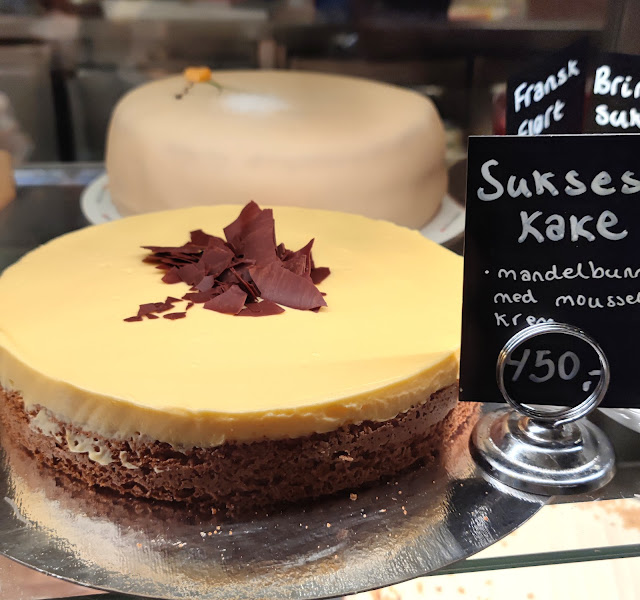





































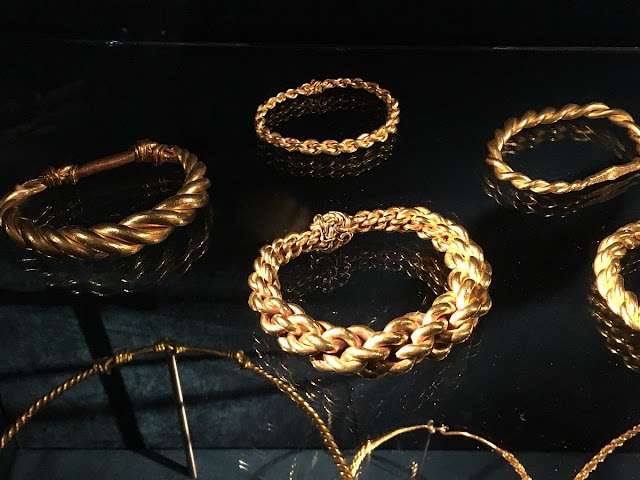
















































































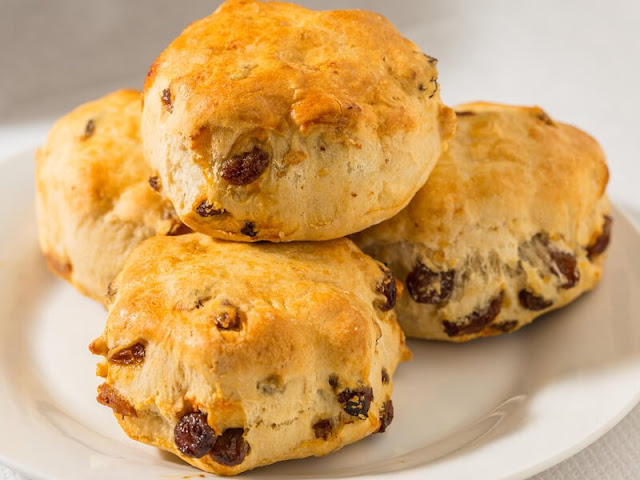


































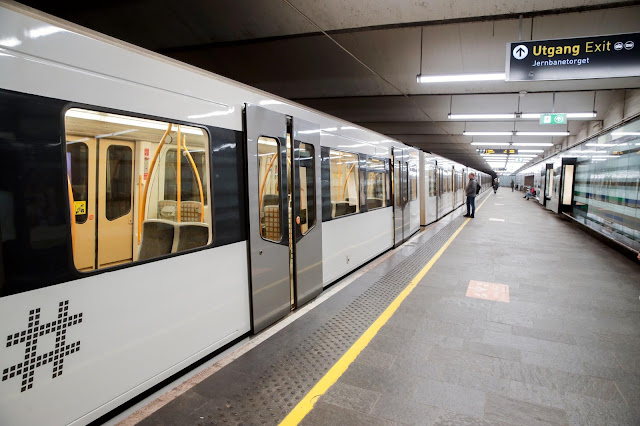


























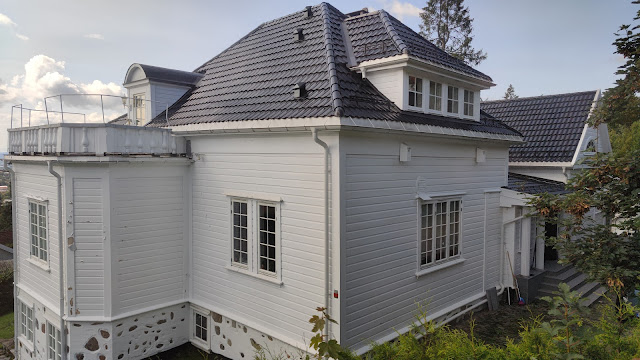

































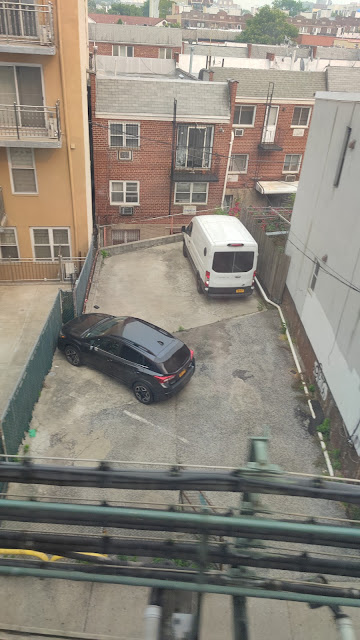
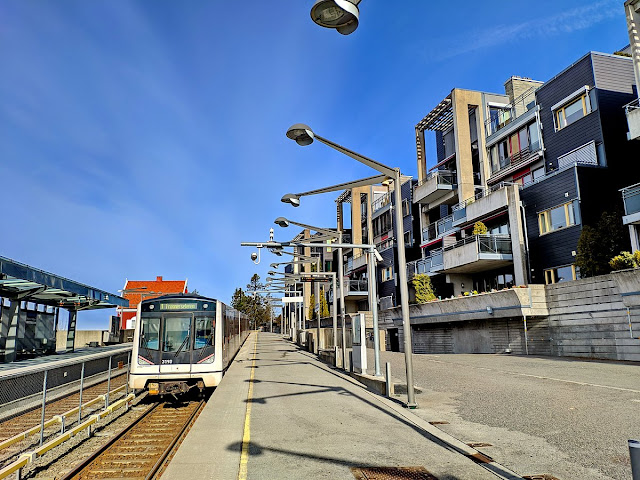

.jpg)
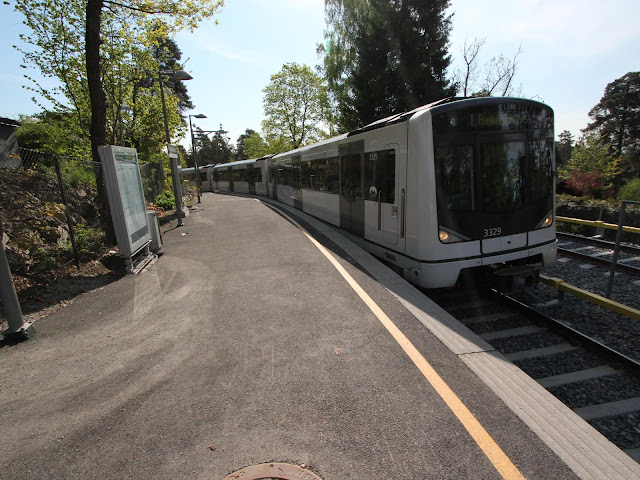







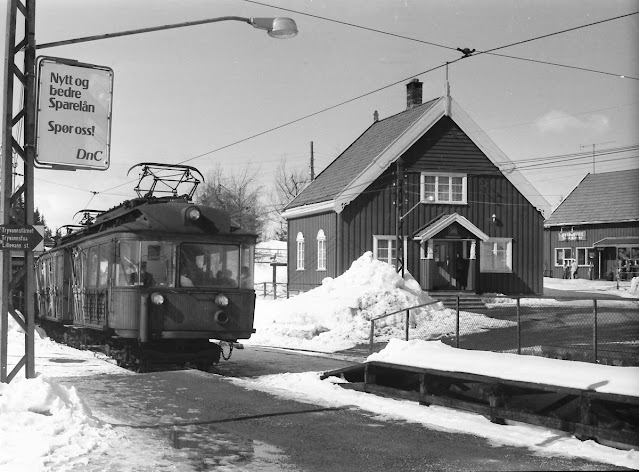





















































































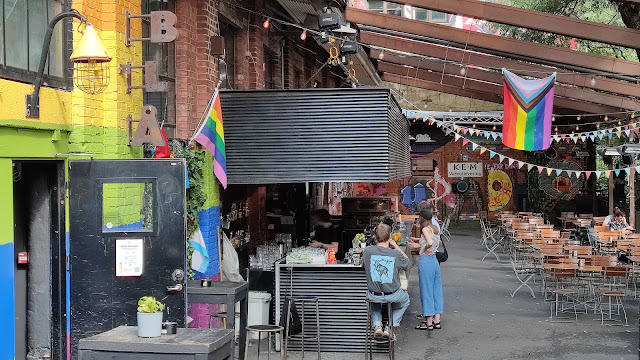












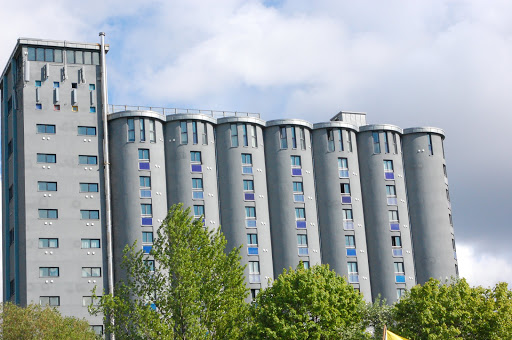





















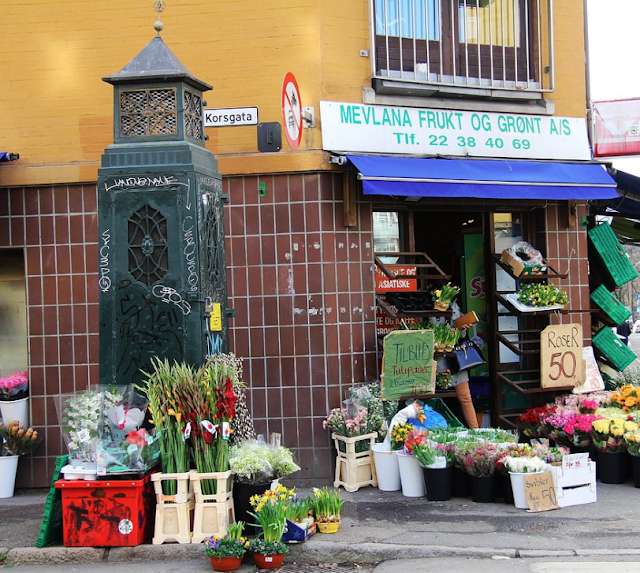









































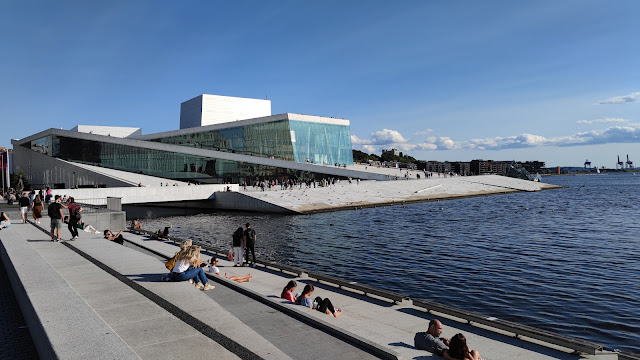
















































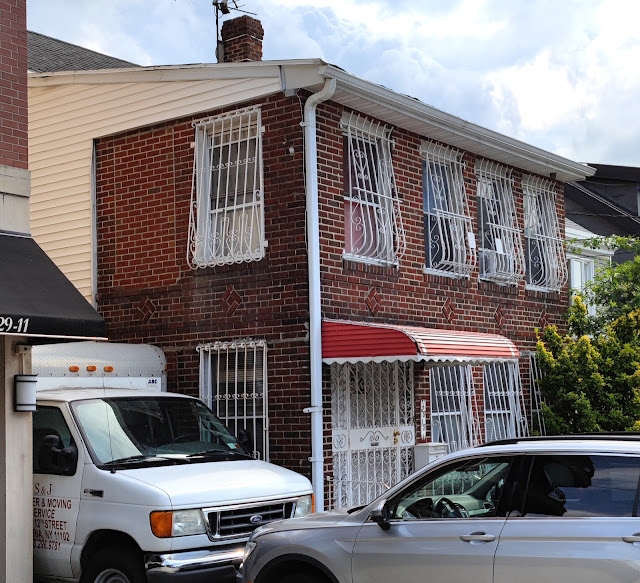







































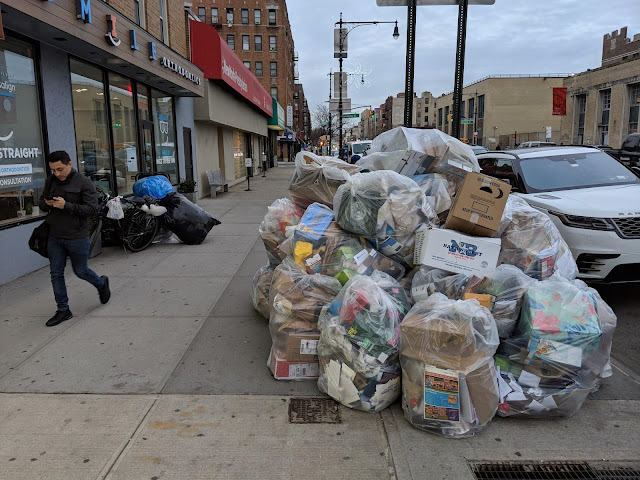












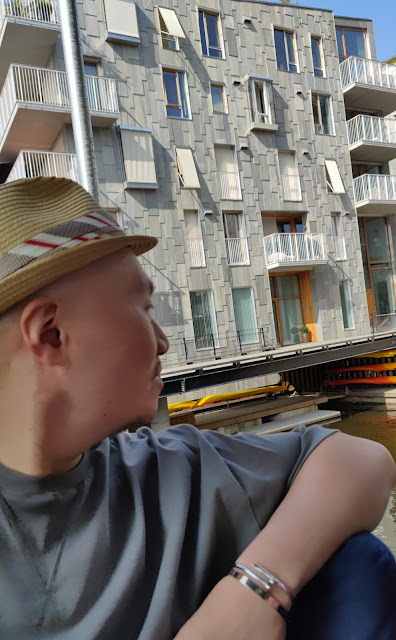
























































.JPG)

_(3610418617).jpg)




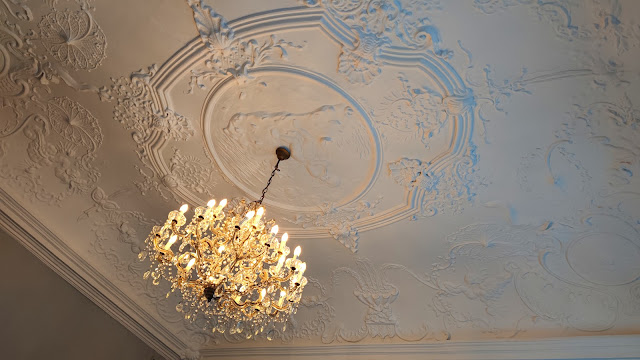



































No comments:
Post a Comment
Don't be shy: leave your comments :)